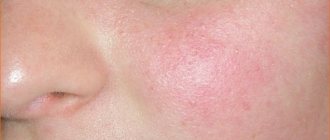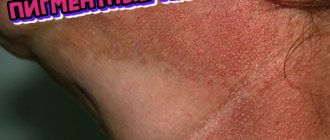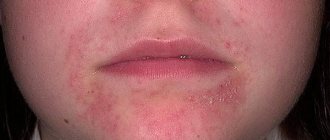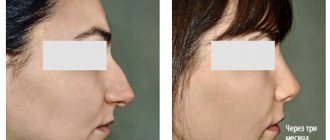From the earliest stages, pregnant women begin to experience changes in the form of the appearance of areas of pigmentation on the skin. First, the external genitalia and nipple areolas darken. Later, some expectant mothers develop spots on their faces, and if a woman had freckles before pregnancy, their number can increase significantly, and they become brighter. Pigmentation during pregnancy is not a sign of pathology, but many are concerned about the question of how to get rid of spots and whether they will go away after childbirth.
Should I worry?
Pigmentation during pregnancy is normal. First of all, the nipple halos and external genitalia darken, then spots appear on the face. If there are all the freckles, then their number will increase.
Sometimes darkening is a sign of melanoma. In this case, the spot will quickly increase in size, have unclear boundaries, itch, and rise above the surface of the skin. Unusual voluminous spots are a reason to consult a doctor.
Where does skin pigmentation occur during pregnancy?
Pigmentation on the body of a pregnant woman can appear in a variety of areas of the skin. Most often, the face, neck, décolleté and back, arms, and stomach suffer from this cosmetic defect. Sometimes pigment spots cover those places where clothing fits tightly - these are the armpits and thighs. Pregnant women often experience pigmentation in the breast area (nipples and areolas), as well as on the labia.
Pigment spots on the face during pregnancy
The face is more likely to develop pigmentation during pregnancy. Darkened spots form in the area of the nasolabial triangle (under the eyes, on the nose, above the lip, on the chin). In many pregnant women, age spots on the face appear in the form of a frontal rim, stretching from one temple to another. Often such a defect also covers the cheeks. The shape and size of such spots on the face are varied. They can be blurry, merging with each other, or have a clear outline. The color is mainly brownish, its intensity depends on the color of the skin. Closer to the second trimester, the color becomes brighter and the spots more noticeable.
Attention! Red-haired women with freckles and those with dark skin are especially susceptible to the appearance of bright brown spots on the face during pregnancy.
Pigmentation on the neck during pregnancy
Pigmentation on the neck also begins to appear in the second decade of pregnancy. The back of the neck is mainly affected, where dark horizontal stripes form on the folds. Often spots appear in places below the ears and in front, smoothly moving into the décolleté area. Color varies from light brown to dark shades.
Nipple pigmentation during pregnancy
Darkening of the areola around the nipples is a normal process during pregnancy. Such pigmentation of the nipples during pregnancy will remain after childbirth during lactation. The process of changing the color of the skin around the nipples is associated with changes in hormonal levels. It is impossible to eliminate or influence darkening. And this is not required, since it is a natural change. But the formation of dark pigment spots under the breasts and in the décolleté area is not always considered normal, as it can be caused by a lack of vitamins in the body of the expectant mother. Therefore, it is imperative to consult with an obstetrician-gynecologist to identify and eliminate the cause of this cosmetic defect.
Pigmentation on hands during pregnancy
If you had freckles on your arms or legs before pregnancy, they will become more pronounced. But unlike pigmentation on the face, darkening on the hands appears later - by the third trimester.
If the color is brown, the only thing you need to worry about is that your body may not have enough vitamins. Red spots symbolize allergic irritation. If white spots with a clear outline appear that expand over time, you should definitely contact your doctor.
Pigment spots on the back during pregnancy
Pigmentation on the back often appears due to exposure to sunlight. In other words, melanin is redistributed in the back area due to the fact that the skin in this area was most exposed to ultraviolet radiation. Typically, pigment spots on a pregnant woman’s back appear by the third trimester in the summer or early autumn, when the skin is most unprotected from the sun.
Pigmentation on the stomach in pregnant women
On the stomach, most often it is not spots that appear, but pigmentation in the form of an Alba stripe. Absolutely all women have it, and it is located between the rectus abdominis muscles, running along from the navel to the pubis. It clearly appears in the third trimester of pregnancy, but may darken earlier.
Pigmentation during pregnancy on the abdomen, in the form of an Alba stripe, is clearly visible in the photo below.
Reasons for appearance
The reasons vary. They are divided into:
- internal;
- external;
- possible diseases and genetic predisposition.
In each of these cases, there is an increased production of melanin in any case.
Domestic
While carrying a child, the expectant mother's body undergoes restructuring. This results in pigmentation for the following reasons:
Hormonal changes occur. Active production of progesterone and estrogens begins.- Before pregnancy, the girl took hormonal contraceptives.
- Late pregnancy (35+).
- Taking medications for epilepsy.
- Lack of vitamin D, folic acid, calcium.
- Disorders of the liver, pituitary gland, ovaries.
Before conceiving, doctors recommend undergoing a full examination, so that later you don’t wonder where the ugly spots came from and don’t think about how to get rid of them.
External
External signs are less likely to affect skin changes, but this is possible. Among them:
- use of certain cosmetics;
- long exposure to the sun;
- frequent visits to the solarium.
By avoiding this, you can prevent the appearance of stains.
Possible diseases and heredity
Sometimes diseases of the internal organs lead to the formation of spots on the face. The problems concern the liver and the female reproductive system.
If you are predisposed due to certain pathologies, pigmentation may also appear.
Manifestations and localization
Pigmentation does not occur simultaneously during pregnancy. Most often, the spots are localized in the forehead area, around the eyes. The cheekbones, nose and chin also darken. A pigmented area appears on the inner thigh, nipples, and abdomen. Typically, a dark line appears on the skin of the abdomen from the navel to the pubic area between 28 and 30 weeks.
Sometimes the appearance of a “mask of pregnant women” is observed, when darkening is observed along the entire length of the forehead, moving to the nose and cheeks. The labia and the places of greatest friction darken at the same time - the armpits, neck, and perineal area.
There is a belief that the strength of changes or features of the pattern are directly related to the gender of the unborn child. But, as experience shows, such a dependence does not exist.
It is important to differentiate spots resulting from hyperpigmentation from pityriasis rosea . In the second case, treatment is required, so if any formations appear on the skin, you should consult a dermatologist.
Treatment of chloasma
Therapy depends on the reasons that influenced the occurrence of the rash. The main goal of therapy is to reduce melanin production and normalize skin color .
Treatment is aimed at:
- Restoration of hormonal levels.
- Elimination of the disease that caused pigmentation of the dermis.
- Proper nutrition, enriched with vitamins and microelements.
- Regulation of metabolic processes.
- The use of cosmetic products to eliminate the effects of pigmentation.
The doctor should prescribe therapy after diagnosing and making an accurate diagnosis. Self-medication is prohibited.
Unauthorized use of vitamin complexes is also not allowed: an excess of vitamins affects the body as negatively as a deficiency.
Some women, before visiting a specialist, carefully look at the form of chloasma, trying to determine from them who will be born - a boy or a girl. This popular belief appeared a long time ago, but it has been scientifically proven that it has no basis.
Facial wipes
Home remedies that almost everyone has at hand will help you cope with pigmentation during an “interesting situation.” This:
- berries;
- lemon;
- Castor oil;
- parsley.
Everything can be used.
Berries
Strawberries, lingonberries, cranberries or raspberries are perfect. To do this, the berries should be crushed, packaged in molds and placed in the freezer, then wipe your face with the resulting cubes.
You can squeeze juice out of fruits and freeze them too.
Lemon
Citrus fruits have long been used to rejuvenate, brighten and tighten the skin. To make the rub, squeeze out the juice of two fruits, add 2 tbsp. honey and stir thoroughly. The skin is wiped every evening.
Castor oil
The product effectively fights many skin defects, including chloasma. It is enough to wipe your face with oil once a day, and you can soon forget about your problems.
Parsley
Squeeze the juice from the fresh leaves of the plant and wipe your face with it twice a day. Can be frozen for future use.
Pigmentation lotions
Using one method is good, but using several is an opportunity to quickly eliminate pigmentation on the face during pregnancy.
The lotions are:
- lemon and honey;
- black currant;
- kefir or yogurt.
Lemon juice and honey
For the lotion, use the juice of one lemon and a few tablespoons of honey.
By adding 2-3 drops of castor oil, you can achieve a better effect. Apply the product on the sponge to the problem area and leave for 5-10 minutes.
Black currant
The berry pulp perfectly removes chloasma. The currants need to be crushed in a blender, and the resulting mixture should be applied to the stains. You can add a little water to the mixture to make the product a little thinner and easier to apply.
Kefir or yogurt
Fermented milk products have long been used to whiten skin . The product must be applied to a sponge and applied to the stain.
The lotions are left on the skin for no more than 15 minutes.
When does pigmentation go away?
The appearance of pigmentation on a woman’s face during pregnancy is considered common and is not a pathological change. The spots are temporary and disappear after childbirth and breastfeeding. This usually occurs after normalization of weight, restoration of abdominal muscle tone and hormonal levels. Normally, this process takes approximately two or three months.
If, after quite a long time, pigmentation persists or intensifies, the woman should consult a doctor. Usually such deviations are dealt with by a dermatologist or cosmetologist. In case of pathology of the internal secretion organs, consultation with an endocrinologist is necessary.
Effective masks
Prepared from the following ingredients:
- starch and lemon (juice);
- cucumber;
- honey with lemon and vinegar;
- parsley.
Potato starch and lemon juice
To prepare the mask, take 1 tbsp. starch, add the juice of 1 lemon and mix thoroughly. Apply for 10 minutes, then wash off.
Cucumber
Cucumber mask is the simplest but most effective. To prepare it, just take 1-2 small cucumbers, grate them, and apply the paste on your face.
After 15-20 minutes, rinse off the product with cool water.
It is recommended to perform the procedure several times a week. Having noticed improvements, they use it less often.
Vinegar, lemon and honey
You should take several lemons, squeeze the juice out of them, add 1 tsp. vinegar and a little honey to make a viscous mass. This remedy should be applied to the chloasma and left for 20 minutes, and then rinsed off.
Lemon juice and vinegar perfectly whiten the skin, but at the same time, the acid irritates it somewhat, so it is recommended to use this mask no more than twice a week.
Having achieved a good result, it is better to switch to using other means to consolidate it.
Parsley
You need to take a bunch of parsley, wash it, grind it in a blender to a paste. It is applied to dark spots and washed off after 10-15 minutes with warm water.
Pharmacy and cosmetics
Ready-made ointments will help remove chloasma.
Retinoic
In recent years, Retinoic ointment has been gaining popularity. It contains a number of components that effectively whiten the skin.
Pregnant women are allowed to use the product, but not often, because due to the use of the ointment, an excess of vitamin A may occur in the body. The product is applied in a thin layer to the chloasma no more than once a day.
Salicylic ointment
The drug has excellent whitening properties. It must be applied depending on the degree of darkening of the stain.
Apply lightly to light areas once a day. And dark ones - up to three times thick. You need to make sure that the ointment does not get on birthmarks and moles.
Zinc
The ointment contains Vaseline and zinc oxide. Its main advantage is its harmlessness. The paste is allowed to be used both before and after childbirth. To get rid of pigmentation, use the product 3-5 times a day.
Salicylic-zinc
The ointment combines the advantages of the first two. It consists of zinc oxide and salicylic acid.
Acid is involved in the breakdown of the stratum corneum of the dermis, and zinc oxide suppresses the production of melanin. The ointment should be applied to cleansed skin several times a day.
Recommendations from cosmetologists
Pigmentation in pregnant women is a common phenomenon, and cosmetologists have important notes on this matter that will help not only get rid of age spots, but also avoid their appearance:
- do not be in direct sunlight from 12:00 to 18:00, since this time is the most dangerous for the dermis sensitive to ultraviolet rays;
- when going outside in the summer, put on a hat and try to protect your skin from sun exposure, and if you need to go out on a hot street, always apply sunscreen;
- The ideal option for pregnant women would be to give up decorative cosmetics, but since not everyone is ready for such a drastic step, equip your arsenal with high-quality and hypoallergenic products;
- ensure that the skin does not come into contact with chemicals;
- Multivitamin preparations prescribed by the doctor will help improve your mood and appearance;
- to combat pigmentation, use home and medicinal remedies, excluding chemical peels and polishing;
- It is better for pregnant girls to start their day by washing with herbal decoctions based on parsley, dandelions, linden, nettle, etc.
Cosmetologists assure that it is better to begin the fight against pigmentation after childbirth, when the body begins to recover and return to its normal state. The spots will disappear gradually, first becoming lighter and then decreasing in size.
The problem will go away on the face after 1-2 months, but pigmentation on the abdomen during pregnancy takes longer to disappear. So, this can take from 4 months to a year. In advanced cases, pigmentation persisted for 2 years. If after the specified time the pigmentation has not decreased, and there are no prerequisites for its removal, you need to contact a gynecologist, therapist and dermatologist and take tests to check the internal organs.
Speaking about how to avoid pigmentation during pregnancy, you must first of all eliminate the use of coloring products, spend less time under the sun, and saturate your diet with vitamins.
How to care for your skin during pregnancy and lactation, watch the video:
Prevention of age spots
The formation of dark spots can be prevented. To do this you should:
Six months before planning a pregnancy, get examined. When identifying diseases that lead to pigmentation, you need to treat the pathologies.- During pregnancy, take folic acid and multivitamins.
- Protect skin from exposure to ultraviolet radiation.
- Eat right, include vegetables, fruits, fish, and plenty of dairy products in your diet.
These recommendations will reduce the risk of pigmentation.










